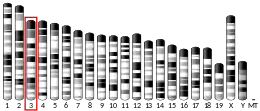GPR61
Probable G-protein coupled receptor 61 is a protein that in humans is encoded by the GPR61 gene.[5][6][7]
| GPR61 | |||||||||||||||||||||||||
|---|---|---|---|---|---|---|---|---|---|---|---|---|---|---|---|---|---|---|---|---|---|---|---|---|---|
| Identifiers | |||||||||||||||||||||||||
| Aliases | GPR61, BALGR, GPCR3, G protein-coupled receptor 61 | ||||||||||||||||||||||||
| External IDs | OMIM: 606916 MGI: 2441719 HomoloGene: 12910 GeneCards: GPR61 | ||||||||||||||||||||||||
| |||||||||||||||||||||||||
| |||||||||||||||||||||||||
| |||||||||||||||||||||||||
| Orthologs | |||||||||||||||||||||||||
| Species | Human | Mouse | |||||||||||||||||||||||
| Entrez | |||||||||||||||||||||||||
| Ensembl | |||||||||||||||||||||||||
| UniProt | |||||||||||||||||||||||||
| RefSeq (mRNA) | |||||||||||||||||||||||||
| RefSeq (protein) | |||||||||||||||||||||||||
| Location (UCSC) | Chr 1: 109.54 – 109.55 Mb | Chr 3: 108.15 – 108.15 Mb | |||||||||||||||||||||||
| PubMed search | [3] | [4] | |||||||||||||||||||||||
| Wikidata | |||||||||||||||||||||||||
| |||||||||||||||||||||||||
This gene belongs to the G-protein coupled receptor 1 family. G protein-coupled receptors contain 7 transmembrane domains and transduce extracellular signals through heterotrimeric G proteins. The protein encoded by this gene is most closely related to biogenic amine receptors.[7]
References
- GRCh38: Ensembl release 89: ENSG00000156097 - Ensembl, May 2017
- GRCm38: Ensembl release 89: ENSMUSG00000046793 - Ensembl, May 2017
- "Human PubMed Reference:". National Center for Biotechnology Information, U.S. National Library of Medicine.
- "Mouse PubMed Reference:". National Center for Biotechnology Information, U.S. National Library of Medicine.
- Lee DK, George SR, Cheng R, Nguyen T, Liu Y, Brown M, Lynch KR, O'Dowd BF (Feb 2001). "Identification of four novel human G protein-coupled receptors expressed in the brain". Brain Res Mol Brain Res. 86 (1–2): 13–22. doi:10.1016/S0169-328X(00)00242-4. PMID 11165367.
- Cikos S, Gregor P, Koppel J (Nov 2001). "Cloning of a novel biogenic amine receptor-like G protein-coupled receptor expressed in human brain". Biochim Biophys Acta. 1521 (1–3): 66–72. doi:10.1016/s0167-4781(01)00289-5. PMID 11690637.
- "Entrez Gene: GPR61 G protein-coupled receptor 61".
Further reading
- Gregory SG, Barlow KF, McLay KE, et al. (2006). "The DNA sequence and biological annotation of human chromosome 1". Nature. 441 (7091): 315–21. doi:10.1038/nature04727. PMID 16710414.
- Kimura K, Wakamatsu A, Suzuki Y, et al. (2006). "Diversification of transcriptional modulation: Large-scale identification and characterization of putative alternative promoters of human genes". Genome Res. 16 (1): 55–65. doi:10.1101/gr.4039406. PMC 1356129. PMID 16344560.
- Conner AC, Hay DL, Simms J, et al. (2005). "A key role for transmembrane prolines in calcitonin receptor-like receptor agonist binding and signalling: implications for family B G-protein-coupled receptors". Mol. Pharmacol. 67 (1): 20–31. doi:10.1124/mol.67.1.20. PMID 15615699.
- Gerhard DS, Wagner L, Feingold EA, et al. (2004). "The Status, Quality, and Expansion of the NIH Full-Length cDNA Project: The Mammalian Gene Collection (MGC)". Genome Res. 14 (10B): 2121–7. doi:10.1101/gr.2596504. PMC 528928. PMID 15489334.
- Strausberg RL, Feingold EA, Grouse LH, et al. (2003). "Generation and initial analysis of more than 15,000 full-length human and mouse cDNA sequences". Proc. Natl. Acad. Sci. U.S.A. 99 (26): 16899–903. doi:10.1073/pnas.242603899. PMC 139241. PMID 12477932.
- Takeda S, Kadowaki S, Haga T, et al. (2002). "Identification of G protein-coupled receptor genes from the human genome sequence". FEBS Lett. 520 (1–3): 97–101. doi:10.1016/S0014-5793(02)02775-8. PMID 12044878. S2CID 7116392.
See also
- GPR61+receptor,+human at the US National Library of Medicine Medical Subject Headings (MeSH)
This article incorporates text from the United States National Library of Medicine, which is in the public domain.
This article is issued from Wikipedia. The text is licensed under Creative Commons - Attribution - Sharealike. Additional terms may apply for the media files.



